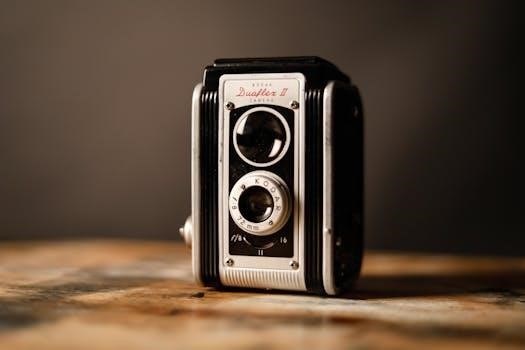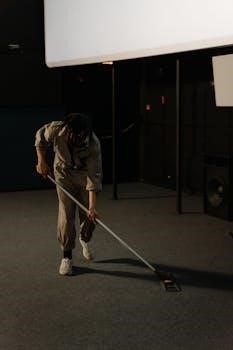
Kodak 35 Service Manual Overview
The Kodak 35 series, a line of classic 35mm cameras, is supported by various service manuals․ These manuals provide repair guidance․ They cover different models, including the Kodak 35 RF and Signet 35․ Availability includes factory manuals and online resources․ These resources are vital for camera maintenance․
The Kodak 35 series represents a significant chapter in the history of 35mm photography, showcasing Kodak’s foray into compact and user-friendly cameras․ These cameras, produced primarily during the mid-20th century, embody a blend of robust construction and functional design, appealing to both amateur and professional photographers․ The series includes several models, each with its own unique features and characteristics, from the basic Kodak 35 to the more advanced Kodak 35 RF with its rangefinder focusing system․ The designs often featured rounded forms and a compactness that made them popular for everyday use․ Their mechanical simplicity also contributes to a kind of beauty, reflecting an era where functionality was paramount․ These models were designed for ease of use, with intuitive controls for loading film and adjusting settings․ The lenses, often Anastigmat or Anastar, were known for delivering good picture quality․ They have become sought-after items for collectors and vintage camera enthusiasts today․
Availability of Kodak 35 Service Manuals
Locating service manuals for the Kodak 35 series can be a task that requires exploration of different resources․ Original factory service manuals, often large format and illustrated, are available for certain models like the Kodak 35 RF․ These manuals provide detailed, step-by-step repair instructions, along with parts lists and diagrams, which are helpful for disassembly and reassembly․ Some of these are available as scanned downloads, sometimes in multiple parts due to the document size․ Additionally, there are community-driven online forums and websites that offer free step-by-step repair instructions, manuals, schematics, and other do-it-yourself resources․ Some online libraries also host scanned versions of these service manuals․ While some manuals are free, others may require a donation․ These manuals are vital for anyone looking to maintain or repair these vintage cameras․ Some manuals are model specific, such as for the Kodak Motormatic 35․ They often include detailed information on film transport mechanisms and specific repair procedures․

Specific Kodak 35 Models and Manuals

Several Kodak 35 models have specific service manuals․ These include the Kodak 35 RF, Signet 35, and Motormatic 35․ Each manual provides detailed repair information for the particular camera model․ These resources are vital for accurate maintenance․
Kodak 35 RF Service Manual
The Kodak 35 RF, an upgraded version of the original Kodak 35, has its dedicated service manual․ This manual, often available as a scanned document, provides essential repair information․ It includes details about the camera’s unique rangefinder system, which is a key feature․ The manual is typically formatted in a small size, around 3×5 inches, but scanned at high resolution to ensure clarity․ The Kodak 35 RF service manual can be found online, often divided into parts due to the large file size․ These resources help in proper maintenance, addressing issues specific to this model․ Additionally, both factory service and US military repair manuals are available for this particular camera․ The manual assists in understanding the complex internal mechanisms, such as the lens assembly and film transport․ It’s a crucial resource for any repair work on this vintage camera, as it provides a detailed guide for disassembly and reassembly․
Kodak Signet 35 Service Manuals
The Kodak Signet 35, a notable member of the Signet series, has its own set of service manuals․ These manuals are crucial for maintaining and repairing these top-of-the-line 35mm cameras․ The service manuals for the Signet 35 often include detailed instructions and diagrams․ They provide a comprehensive guide to the camera’s internal mechanisms․ These resources are essential for addressing any issues that might arise, ranging from lens problems to film transport malfunctions․ The manuals often include step-by-step repair procedures and troubleshooting tips․ They also cover aspects like lens assembly removal and reassembly․ The Signet 35 manuals may also contain detailed exploded parts listings and diagrams, aiding in accurate reassembly․ They are often found as scanned documents․ These guides are invaluable for both amateur and professional camera repair enthusiasts working on the Kodak Signet 35 camera․ Specific instructions are usually provided for maintaining optimal camera function․
Kodak Motormatic 35 Service Manual
The Kodak Motormatic 35 service manual is a specific resource for this particular model․ It is often provided by the factory and includes parts lists and exploded diagrams․ It offers functional-based service instructions, often referencing repair schedules from Eastman Kodak Company; These manuals typically cover specific aspects related to the camera’s unique features, such as its film transport mechanism․ The Motormatic 35 manual focuses on aspects applicable to this specific model, omitting repair classifications that do not apply․ It delves into areas like the camera’s motor drive system and film advance․ The manual provides detailed procedures for addressing any issues related to its automatic features․ They also help with standard maintenance․ They offer comprehensive guidance for the camera’s mechanical and electrical systems․ They are essential tools for any repair work on the Kodak Motormatic 35 camera․ The manuals include specifications to ensure correct repairs․

Repair Information and Procedures
Repairing Kodak 35 cameras involves understanding general instructions, typical problems, and specific procedures․ This includes lens assembly removal, top cover handling, and spring management․ These steps are essential for proper maintenance and functionality restoration․ Manuals guide these processes․
General Repair Instructions for Kodak 35
When undertaking repairs on a Kodak 35 camera, it’s crucial to start with a clean and stable workspace․ Ensure all necessary tools are at hand before commencing any disassembly․ Begin by carefully examining the camera for any visible damage or signs of wear․ Familiarize yourself with the camera’s specific model, as variations exist between the series․ Before removing any parts, take photographs to aid reassembly․ Pay close attention to the order in which components are detached, noting the orientation of each․ When dealing with screws, use the correct screwdriver size to avoid stripping the heads․ Remember that some parts, like those in the viewfinder or rangefinder, are small and delicate․ Proceed methodically, avoiding rushing, and if unsure, refer back to the service manual diagrams for guidance․ It is also beneficial to use a Ronsonol or other electronic cleaning fluid to clear grime․ Be gentle and patient during each stage of the repair process․ Proper cleaning and lubrication are key to restoring smooth operation․
Typical Problems and Evaluation
When evaluating a Kodak 35 camera for potential issues, certain common problems frequently arise․ A sticky shutter is a prevalent concern, often caused by dried lubricants or accumulated grime․ Check the film advance mechanism for smooth operation․ A stiff or unresponsive advance may point to internal issues․ Inspect the lens for signs of fungus, haze, or scratches․ The rangefinder, if present, should be examined for accuracy and clarity․ Look for any signs of light leaks around the camera body and seals․ A common issue can be the viewfinder glass which should be secure in its frame․ Pay attention to the condition of the springs, particularly those associated with the top cover and film advance․ Loose or corroded screws and connections can cause malfunctions; When inspecting, carefully note any unusual sounds or resistance․ It’s crucial to assess the overall condition of the camera body, looking for any cracks or damage․
Lens Assembly Removal and Reassembly
Removing the lens assembly on a Kodak 35 typically involves a counterclockwise rotation․ Ensure a firm grip on the lens while holding the camera body securely․ Upon removal, note the position and orientation of any shims or spacers․ These are crucial for proper reassembly․ Reassembly requires careful alignment and a clockwise turn․ Ensure that the lens is correctly seated before tightening․ When reassembling, pay close attention to any threads or mechanisms that may be present․ Avoid forcing any parts․ If there is resistance, verify alignment․ It is critical to avoid any cross-threading which will damage the threads․ The lens should move freely․ Clean all parts before reassembly․ This will ensure smooth operation and performance․ This is particularly important for focusing mechanisms․ During reassembly ensure that all parts are properly secured․
Top Cover Removal and Spring Handling
Removing the top cover of a Kodak 35 usually requires unscrewing fasteners located under the rewind and advance knobs․ Once these are removed, carefully lift the top cover, noting the presence of a coiled spring on the advance knob post․ This spring is critical for the film advance mechanism; When removing the top cover, exercise caution to avoid losing or damaging the spring․ Note its orientation for reassembly․ If the spring is dislodged, it can be tricky to replace, and will impact the functionality of the camera․ Proper handling of the spring and its placement is crucial․ After the top cover is removed be careful with the internal mechanisms․ Keep a record of all the parts and their positions․ This ensures that reassembly is correct․ Clean all parts before putting them back in place․ This step helps to avoid any functional issues․

Additional Resources
Repairing Kodak 35 cameras benefits from various resources․ These include parts lists and diagrams, essential tools information, and specifications for film loading․ These resources provide detailed guidance for repairs․ They assist in proper camera operation․
Parts Lists and Diagrams
For effective Kodak 35 camera repairs, detailed parts lists and diagrams are indispensable․ These resources, often found in factory service manuals, provide comprehensive breakdowns of each camera model․ Specifically, for models such as the Kodak 35 RF, Signet 35, and Motormatic 35, these lists detail every component, from screws and springs to lenses and shutter mechanisms․ Exploded diagrams offer a visual guide for disassembly and reassembly, showing the exact location and orientation of each part․ These diagrams are particularly helpful when dealing with intricate mechanisms and small components, where proper placement is critical․ Having access to these part lists and diagrams ensures that repairs are carried out with precision, preventing further damage and ensuring the camera’s functionality is restored correctly․ Moreover, they aid in identifying missing or damaged parts, allowing for targeted replacement․ For instance, the detailed diagrams are valuable when removing and reassembling the lens assembly or the top cover, where understanding the structure is key to successful repair․ The availability of these resources supports accurate and efficient repair procedures for Kodak 35 cameras․
Tools Required for Repair
Repairing Kodak 35 cameras necessitates a specific set of tools to ensure precision and avoid damage․ Essential tools include a Phillips 00 screwdriver for small screws found in intricate mechanisms, along with a flathead 3/32 or 2․5 mm screwdriver for larger screws․ Tweezers are indispensable for handling tiny components and springs, aiding in their removal and placement during disassembly and reassembly․ A 6-in-1 screwdriver can be useful for versatility․ A Phillips 1 screwdriver is needed for some larger screws․ Having a clean and stable work surface is also crucial for organizing parts․ Specific tools, like a film window tool, might be required for particular repairs․ Furthermore, the correct tools will prevent damage to screw heads and delicate parts․ Specialized tools may be needed for particular tasks, such as lens assembly removal or top cover removal․ The correct tools make the repair process more efficient and less frustrating․ Therefore, ensuring you have the proper tools before starting any repair is vital for a successful outcome․ Careful tool selection helps preserve the integrity of the camera․
Film Loading and Specifications
Loading film into a Kodak 35 camera requires careful attention to ensure proper operation and prevent film damage․ The process involves opening the camera back, inserting the film cartridge into the designated chamber, and threading the film leader into the take-up spool․ The film should be advanced using the film advance knob, and the camera back should be closed securely․ Kodak film was recommended for optimal performance, with various types available to meet different picture-taking needs․ The film specifications for the Kodak 35 are typically standard 35mm film, ensuring compatibility with a wide range of film stocks․ Specific instructions on loading are usually detailed in the camera’s manual․ Additionally, understanding the film speed (ISO) settings is crucial for correct exposure․ The proper handling of the film is essential to avoid light leaks or misaligned frames․ The film transport mechanism is designed to move the film smoothly and accurately․ Always consult the specific manual for detailed instructions on film loading and other specifications․